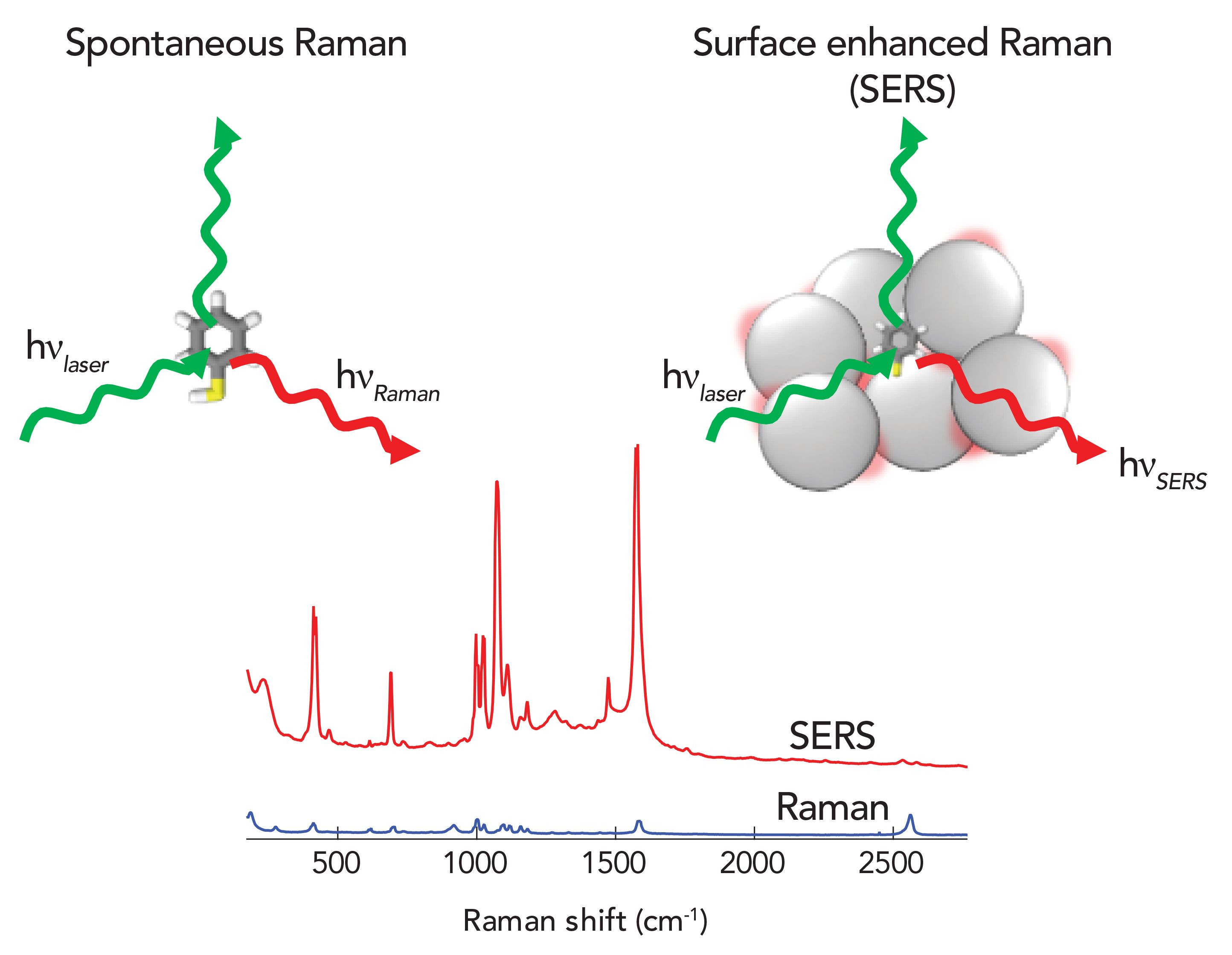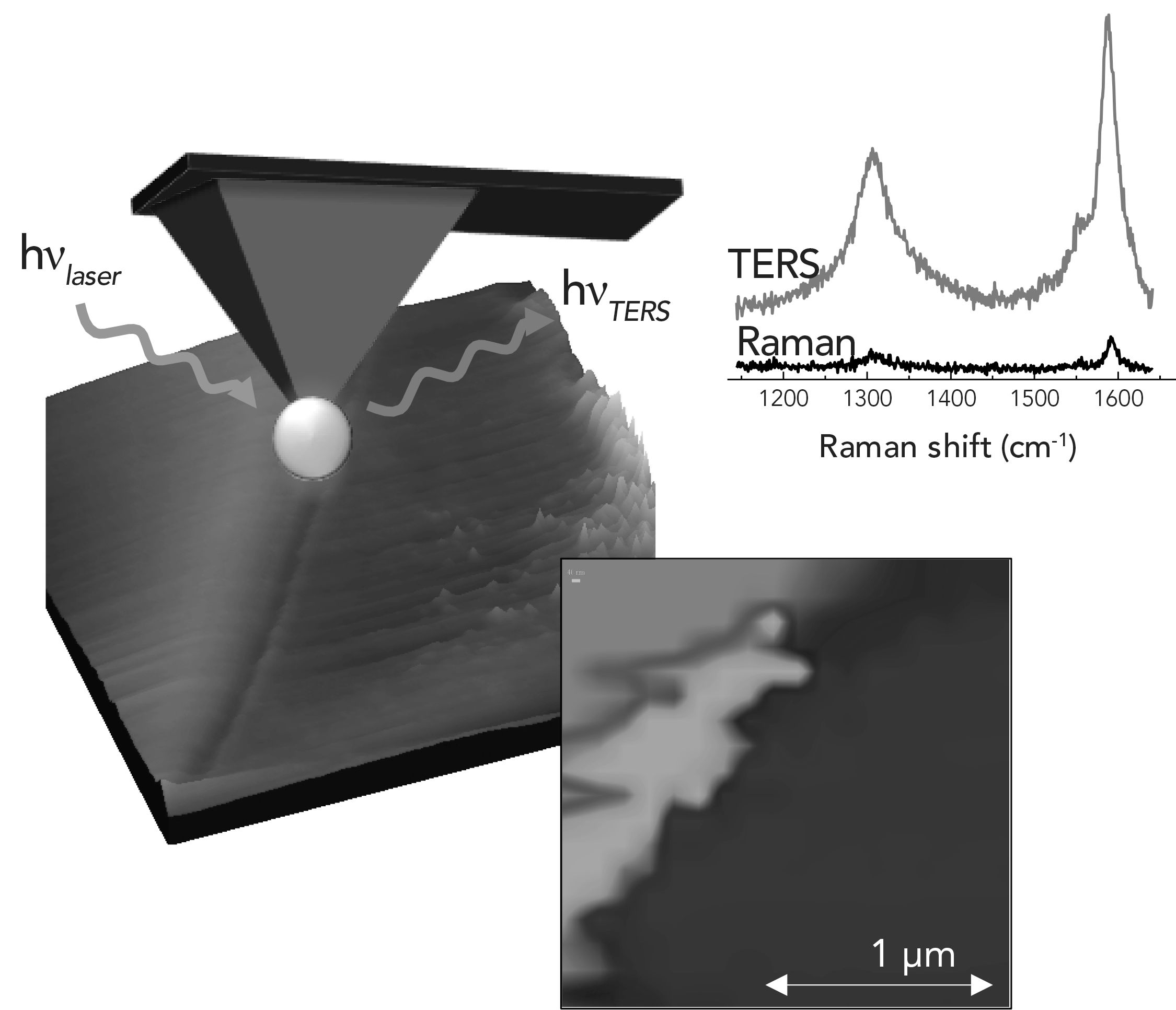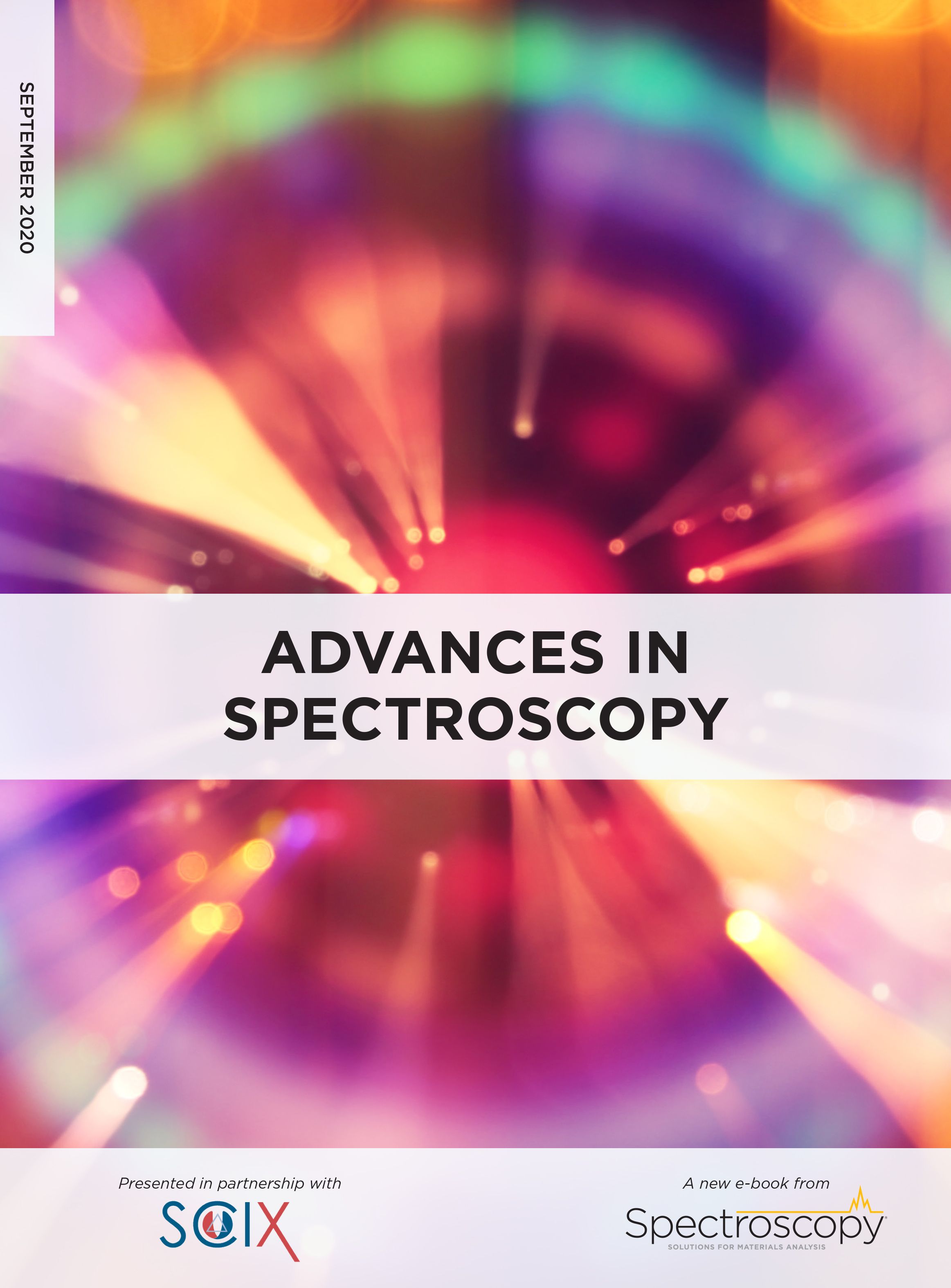SERS and TERS
Surface enhanced Raman scattering (SERS), and the high-resolution imaging analog tip-enhanced Raman scattering (TERS), have emerged as ultrasensitive methods of chemical analysis (1). SERS derives from Raman scattering, and is a nondestructive, label-free, chemicalspecific method. In Raman spectroscopy, laser radiation incident on a molecule is inelastically scattered at frequencies that can be correlated to the vibrational modes of the molecule (2). These vibrational modes are similar to the energy levels probed in infrared spectroscopy and arise from how elements are connected within a molecule. The energy of each vibrational mode is sensitive to interactions with other molecules, temperature, and other conditions, providing insight into physical properties. Additionally, the unique organization and combination of elements that compose a molecule give rise to unique combinations of bands in the Raman spectrum, which is often considered a molecular fingerprint for identification. The challenge with Raman spectroscopy is that the probability of a photon inelastically scattering is very low (about a billion times less than that of a photon fluorescing). Fortunately, in the presence of silver and gold nanostructures, SERS can enhance Raman scattering signals by as much as 1011, such that single molecules can be investigated (3).
The general phenomenon responsible for SERS is shown in Figure 1 and arises from an intense localized electromagnetic field on the nanostructures when the laser excites a localized surface plasmon resonance (LSPR) (4). The LSPR is the collective oscillation of electrons in the conduction band of the metal nanoparticle. Silver and gold nanoparticles are most commonly used because their LSPR is found in the visible region of the electromagnetic spectrum, where most Raman spectroscopy experiments are performed. Other materials can also generate SERS; for example, aluminum nanoparticles exhibit a LSPR at ultraviolet wavelengths and can generate SERS (5). When excited, the oscillation of the electrons concentrates the laser radiation into intense local electromagenetic fields at the nanostructure surface. Molecules in close proximity (generally <5nm) to the nanostructure surface experience this field and generate increased Raman scattering. The Raman scattering occurs at a wavelength similar to the LSPR, causing the nanoparticle to further re-radiate the increased Raman scattering from nearby molecules. In essence, the nanoparticle acts as an antenna to amplify the Raman signal from molecules (6–8).
The electric field in the junction between two plasmonic nanoparticles is significantly larger than on the surface of a single particle and gives rise to very large Raman enhancements. Similarly, asymmetric nanoparticles, such as nanorods and nanostars (9,10), have higher enhancements at points and vertices. Highly enhancing locations are often called “hotspots” and have been shown to dominate the SERS signal (11). Plasmon-enhanced scattering has enabled Raman detection of single molecules and, in some applications, is more sensitive than fluorescence (12,13). At this point, it is well understood the physical interactions that generate a large SERS enhancement; however, controlling the interactions for quantitative analysis has been more challenging. The observed Raman intensity arises from the organization of the nanoparticles and the location of the analyte molecule interacting with the nanoparticles. Although nanoparticles are often modeled as spheres, small features on the surface can modulate the enhanced fields. Additionally, the spacing between particles affects the resulting fields, and forming reproducible aggregates can be challenging and affect the observed signals. Because only molecules near the surface can be detected, the signal saturates at higher concentrations.
TERS
The plasmonic effects that give rise to SERS can also be localized at the apex of a scanning probe microscope tip to perform TERS (14,15). This approach has been demonstrated using both atomic force microscopy (AFM) and scanning tunneling microscopy (STM) to control the position of the tip. The advantage of AFM-based TERS is it can be done on almost any sample, while STM–TERS requires a conductive sample. In either approach, a plasmonic metal nanoparticle (or sharp metal point) is located at the very apex of the tip to generate the Raman signal enhancement from molecules beneath the tip. By controlling the location and configuration of the enhancing nanostructure, high sensitivity spectroscopy can be obtained from precise locations on a sample (16). Figure 2 illustrates how, by scanning the sample under the TERS tip in the laser focus, high spatial-resolution images of samples can be obtained. In ultrahigh-vacuum (UHV) experiments, where molecular motion can be minimized, TERS imaging within a molecule has been demonstrated. Under ambient conditions, TERS experiments are capable of imaging with a spatial resolution of 1 to 2 nm (17–19).
Figure 1: The images illustrate a laser interacting with a thiophenol molecule to scatter light by spontaneous Raman scattering as well as a laser interacting with thiophenol on plasmonic nanoparticles to gen- erate surface enhanced Raman scattering (SERS). The SERS spectra from thiophenol on silver nanostructures and the spontaneous Raman spectrum from pure thiophenol are shown. The enhanced electric field on the nanoparticle surface enhances the observed Raman signal in the SERS experiment. The SERS spectrum arises from ~10,000x fewer molecules, is obtained at lower incident power, and requires shorter acquistion times, demonstrating the signal enhancement.

Applications of SERS and TERS
A number of applications of SERS and TERS have been reported in the literature. Many SERS applications use the enhanced signal for trace detection. A large number of papers have been published describing many ways to generate a SERS substrate, and commercial solutions are available.
One common use is to create “SERS tags,” where a reporter molecule with a strong Raman response is attached to the surface of the nanoparticle along with some kind of recognition agent (such as an antibody or nucleic acid sequence) (20,21). The unique SERS signal from the reporter molecule is used to quantify, and image, the detected analyte. Although this is similar to fluorescence, SERS tags do not photobleach, and the narrow Raman bands allow multiple different tags to be detected and unmixed simultaneously (22).
Figure 2: Tip enhanced Raman scattering (TERS) is performed by positioning a metallic nanoparticle, or sharp metallic point, at the apex of a scanning probe microscope tip. The TERS tip amplifies Raman signal from the molecules immediately beneath it, increasing the observed signal relative to the spontaneous Raman signal without enhancement. By moving the sample with respect to the tip and analyzing the recorded spectra, chemical images, such as the map of multilayer graphene shown, can be obtained. In the TERS map, the red, green, and blue colors correspond to different multilayer thicknesses of the graphene as determined from the TERS spectra.

Other recent work has investigated novel ways to utilize the molecular enhancements for chemical sensing, such as SERS pipettes for optophysiology (23) and online detection with chromatographic separations (24). In addition to analytical experiments, new physical understanding is being uncovered at length scales suggesting picoscience (25). As SERS and TERS continue to mature, one can expect to see these techniques enabling new physical insights and methods of chemical analysis.
References
1. J. Langer, D. Jimenez de Aberasturi, J. Aizpurua, R.A. Alvarez-Puebla, B. Auguié, J.J. Baumberg, G.C. Bazan, S.E.J. Bell, A. Boisen, A.G. Brolo, J. Choo, D. Cialla-May, V. Deckert, L. Fabris, K. Faulds, F.J. García de Abajo, R. Goodacre, D. Graham, A.J. Haes, C.L. Haynes, C. Huck, T. Itoh, M. Käll, J. Kneipp, N.A. Kotov, H. Kuang, E.C. Le Ru, H.K. Lee, J.-F. Li, X.Y. Ling, S. Maier, T. Mayerhoefer, M. Moskovits, K. Murakoshi, J.- M. Nam, S. Nie, Y. Ozaki, I. Pastoriza-Santos, J. PerezJuste, J. Popp, A. Pucci, S. Reich, B. Ren, G.C. Schatz, T. Shegai, S. Schlücker, T. Li-Lin, K.G. Thomas, Z.-Q. Tian, R.P. Van Duyne, T. Vo-Dinh, Y. Wang, K.A. Willets, C. Xu, H. Xu, Y. Xu, Y.S. Yamamoto, B. Zhao, and L.M. Liz-Marzán, ACS Nano. 14, 28–117 (2019).
2. E. Smith and G. Dent, Modern Raman Spectroscopy: A Practical Approach (John Wiley & Sons, Hoboken, New Jersey, 2005).
3. M. Moskovits, J. Raman Spectrosc. 36, 485–496 (2005).
4. P.L. Stiles, J.A. Dieringer, N.C. Shah, and R.R. Van Duyne, Annu. Rev. Anal. Chem. 1, 601–626 (2008).
5. S. Tian, O. Neumann, M.J. McClain, X. Yang, L. Zhou, C. Zhang, P. Nordlander, and N.J. Halas, Nano. Lett. 17, 5071–5077 (2017).
6. K. Yoshida, T. Itoh, H. Tamaru, V. Biju, M. Ishikawa and Y. Ozaki, Phys. Rev. B. 8, 9 (2010).
7. P. Bharadwaj, R. Beams, and L. Novotny, Chem. Sci. 2, 136–140 (2011).
8. L. Novotny and S.J. Stranick, Annu. Rev. Phys. Chem. 57, 303–331 (2006).
9. B. Nikoobakht, Z.L. Wang, and M.A. El-Sayed, J. Phys. Chem. B. 104, 8635–8640 (2000).
10. C.G. Khoury and T. Vo-Dinh, J. Phys. Chem. C. 112, 18849–18859 (2008).
11. Y. Fang, N.H. Seong, and D.D. Dlott, Science 321, 388–392 (2008).
12. D. Graham, R. Stevenson, D.G. Thompson, L. Barrett, C. Dalton, and K. Faulds, Faraday Discuss. 149, 291–299 (2011).
13. I. A. Larmour, K. Faulds, and D. Graham, Chem. Sci. 1, 151–160 (2010).
14. R.M. Stockle, Y.D. Suh, V. Deckert, and R. Zenobi, Chem. Phys. Lett. 318, 131–136 (2000).
15. N. Hayazawa, Y. Inouye, Z. Sekkat, and S. Kawata, Opt. Commun. 183, 333–336 (2000).
16. R. Zhang, Y. Zhang, Z.C. Dong, S. Jiang, C. Zhang, L.G. Chen, L. Zhang, Y. Liao, J. Aizpurua, Y. Luo, J.L. Yang, and J.G. Hou, Nature 498, 82–86 (2013).
17. P.Z. El-Khoury and E. Aprà, J. Physical Chemistry C. 124, 17211–17217 (2020).
18. Z. He, Z. Han, M. Kizer, R.J. Linhardt, X. Wang, AM. Sinyukov, J. Wang, V. Deckert, A.V. Sokolov, J. Hu, and M.O. Scully, J. Am. Chem. Soc. 141, 753–757 (2019).
19. T. Deckert-Gaudig, E. Kaemmer, and V. Deckert, J. Biophotonics 5, 215–219 (2012).
20. D. Graham, B.J. Mallinder and W.E. Smith, Angewandte Chemie Intl. Ed. 39, 1061–1063 (2000).
21. T. Vo Dinh, K. Houck, and D. L. Stokes, Anal. Chem. 66, 3379–3383 (1994).
22. S. Laing, K. Gracie, and K. Faulds, Chem Soc. Rev. 45, 1901–1918 (2016).
23. F. Lussier, D. Missirlis, J. P. Spatz, and J. F. Masson, ACS Nano. 13, 1403–1411 (2019).
24. L. Xiao, C. Wang, C. Dai, L.E. Littlepage, J. Li, and Z.D. Schultz, Angewandte Chemie 59, 3439–3443 (2020).
25. J. Lee, K.T. Crampton, N. Tallarida, and V.A. Apkarian, Nature 568, 78–82 (2019).
Zachary D. Schultz is with the Department of Chemistry and Biochemistry at The Ohio State University, in Columbus, Ohio.


AI Shakes Up Spectroscopy as New Tools Reveal the Secret Life of Molecules
April 14th 2025A leading-edge review led by researchers at Oak Ridge National Laboratory and MIT explores how artificial intelligence is revolutionizing the study of molecular vibrations and phonon dynamics. From infrared and Raman spectroscopy to neutron and X-ray scattering, AI is transforming how scientists interpret vibrational spectra and predict material behaviors.
Nanometer-Scale Studies Using Tip Enhanced Raman Spectroscopy
February 8th 2013Volker Deckert, the winner of the 2013 Charles Mann Award, is advancing the use of tip enhanced Raman spectroscopy (TERS) to push the lateral resolution of vibrational spectroscopy well below the Abbe limit, to achieve single-molecule sensitivity. Because the tip can be moved with sub-nanometer precision, structural information with unmatched spatial resolution can be achieved without the need of specific labels.